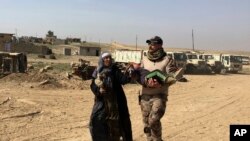An Iraqi commander says his troops are within 800 meters (900 yards) of the main government complex in the northern city of Mosul, the capture of which would mark a symbolic victory against the Islamic State group.
Maj. Gen Thamir al-Hussaini, of Iraq's elite rapid response units, said his forces were advancing along the Tigris River after retaking one of the city's five damaged bridges. He said the capture of the bridge could shorten supply lines and allow civilians in western Mosul, where heavy fighting is underway, to flee to the government-controlled eastern half of the city.
"In the coming day we will clear the government buildings," he told reporters in Abu Saif, a village outside Mosul.
Inside the city, residents described Iraqi forces' hold on the area as much more tenuous.
Within a few hundred meters (yards) of the bridge, makeshift roadblocks set up to prevent car bombs were still in place, preventing civilian and military traffic.
Muhammad Salah, a resident of a recently retaken neighborhood nearby said the bridge and the main road effectively mark the current front-line in the fight. He pointed to plumes of black smoke visible a few blocks away, saying they were from cars along the main road set alight by the militants to conceal their positions from aircraft flying overhead.
"None of the main road has been liberated yet," he said, as black ash drifted down on his garden like a light snow.
Cpl. Hussein Ishaq, of the rapid response units, described the battle for the neighborhood as "simple," saying IS defenses were light and that his forces cleared the district in a single day.
Muhammad Abbas, a member of the militarized Federal Police, pointed to a street corner next to a garden full of fruit trees. "There were two IS fighters there, one with a suicide belt," he said. "A coalition plane saw them and killed them with an airstrike."
The munition left a deep hole in the asphalt. The street was still littered with leaves knocked off the trees, barely recognizable body parts and shreds of clothing.
Residents said Iraqi forces only pushed into the area after days of heavy airstrikes and artillery fire.
"Honestly it was a very fierce fight," said Salah.
The U.N. migration agency meanwhile reported a surge in the number of fleeing civilians, saying over 10,000 men, women and children have been displaced since the operation to retake western Mosul began on Feb. 19. The International Organization for Migration cited Iraqi government figures.
The IOM, citing accounts from those who have fled, said the streets are littered with the bodies of slain IS militants as well as civilians. It said the militants have raided the shops, warehouses and homes of those who have fled as they stockpile supplies.
Families leaving with children are reportedly taping their mouths shut with duct tape, or giving them sleeping pills or Valium in order to prevent them from alerting the militants.
"We stayed out of fear of ISIL," said Umm Mahmoud, 50, who arrived at the government-controlled town of Qayara on Sunday, using an alternative acronym for IS. "People escaping were caught. Their men were killed and the women were left tied up out in the cold as punishment," she said.
More than 220,000 people have fled since U.S.-backed Iraqi forces launched an offensive to retake Mosul in October, according to the IOM. Of those, more than 175,000 remain displaced.
Mosul is Iraq's second largest city, and its western half is the last significant urban area held by IS in the country.







